Top Manufacturers of Cryogenic Check Valves for High-Performance Solutions
Cryogenic Check Valve Manufacturers Ensuring Safety and Efficiency in Cryogenic Applications
Cryogenic check valves play a crucial role in various industrial processes, particularly in applications involving liquefied gases such as nitrogen, oxygen, and helium. These valves are designed to allow fluid flow in one direction while preventing backflow, thus ensuring the safety and efficiency of cryogenic systems. The manufacturing of cryogenic check valves requires specialized knowledge, materials, and engineering expertise to withstand extreme temperatures and pressures. This article explores the significance of cryogenic check valve manufacturers, their manufacturing processes, and the challenges they face in the industry.
Importance of Cryogenic Check Valves
Cryogenic check valves are essential components in a range of applications, from aerospace and medical industries to petrochemical and energy sectors. They are commonly used in liquefied natural gas (LNG) terminals, storage tanks, and transportation systems where maintaining a stable state of the cryogenic liquids is critical. The ability to prevent backflow is vital in these systems to avoid contamination, maintain operational efficiency, and prevent hazardous situations that could lead to serious accidents.
Manufacturing Processes
The manufacturing of cryogenic check valves involves several critical steps
1. Material Selection Due to the extreme cold conditions in which these valves operate, manufacturers must choose materials that can withstand low temperatures without becoming brittle. Common materials include stainless steel, brass, and specialized alloys designed for cryogenic applications. These materials ensure durability and reliability.
2. Design and Engineering Cryogenic check valves must be designed with precision engineering to meet specific pressure and temperature ratings. Manufacturers use advanced CAD software and simulation tools to create designs that optimize flow efficiency and minimize pressure drop. The design phase also includes considerations for maintenance access and ease of installation.
3. Fabrication Once the designs are finalized, the fabrication process begins. This stage typically involves machining, welding, and assembly of various components. Advanced manufacturing techniques, such as CNC machining and laser welding, are often employed to ensure precision and consistency in the production process.
cryogenic check valve manufacturer

4. Testing and Quality Control After fabrication, each valve undergoes rigorous testing to ensure it meets stringent industry standards. This includes pressure testing, leak testing, and assessment of flow rates. Quality control measures are essential to ensure that every valve can perform reliably in cryogenic conditions without failure.
Challenges Faced by Manufacturers
Despite the growing demand for cryogenic systems, manufacturers in this niche market face several challenges
1. Regulatory Compliance The cryogenic industry is subject to strict regulations regarding safety, environmental impact, and operational efficiency. Manufacturers must stay updated on regulatory changes and ensure their products comply with all applicable codes and standards, which can vary by region.
2. Economic Factors The market for cryogenic technologies is influenced by economic fluctuations, including the price of raw materials and the demand for energy resources. Manufacturers often need to adjust their pricing and production strategies in response to these unpredictabilities.
3. Technological Advancement As technology evolves, manufacturers must continuously innovate to develop more efficient and reliable products. This requires investment in research and development, which can be a significant undertaking for companies in this sector.
4. Competition The market for cryogenic check valves is competitive, with numerous manufacturers vying for market share. Companies must differentiate themselves through product innovation, quality, and customer service to maintain their position in the industry.
Conclusion
Cryogenic check valve manufacturers play a vital role in ensuring the safety and efficiency of various industrial processes involving cryogenic fluids. Their ability to produce high-quality, reliable valves depends on advanced manufacturing techniques, stringent quality control measures, and an understanding of the unique challenges posed by the cryogenic environment. As the demand for liquefied gases continues to grow, the importance of skilled manufacturers in this field will only increase, driving innovation and improvements across industries that rely on cryogenic technologies. Whether in aerospace, energy, or healthcare, the contribution of these manufacturers is integral to the advancement of safe and efficient cryogenic systems.
-
The Key to Fluid Control: Exploring the Advantages of Ball Valves in Industrial SystemsNewsJul.09,2025
-
The Versatile World of 1, 2, and 3 Piece Ball ValvesNewsJul.09,2025
-
Stainless Steel Ball Valves: The Ideal Choice for Efficient Flow ControlNewsJul.09,2025
-
Optimizing Fluid Control with Ball Float ValvesNewsJul.09,2025
-
Manual Gate Valves: Essential for Control and EfficiencyNewsJul.09,2025
-
Everything You Need to Know About Butterfly ValvesNewsJul.09,2025
-
The Versatility of Wafer Type Butterfly ValvesNewsJul.08,2025




